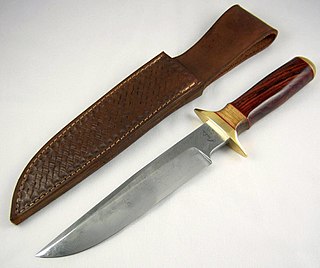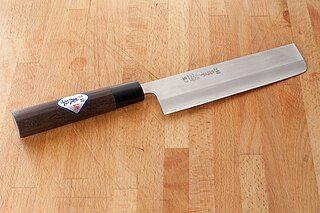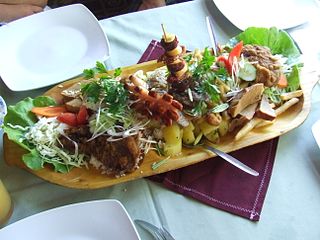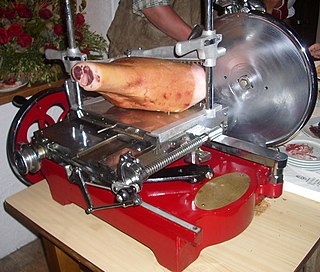
A knife is a tool or weapon with a cutting edge or blade, usually attached to a handle or hilt. One of the earliest tools used by humanity, knives appeared at least 2.5 million years ago, as evidenced by the Oldowan tools. Originally made of wood, bone, and stone, over the centuries, in step with improvements in both metallurgy and manufacturing, knife blades have been made from copper, bronze, iron, steel, ceramic, and titanium. Most modern knives have either fixed or folding blades; blade patterns and styles vary by maker and country of origin.

A mandoline or mandolin, is a culinary utensil used for slicing and for cutting juliennes; with suitable attachments, it can make crinkle-cuts.

A Japanese kitchen knife is a type of a knife used for food preparation. These knives come in many different varieties and are often made using traditional Japanese blacksmithing techniques. They can be made from stainless steel, or hagane, which is the same kind of steel used to make Japanese swords. Most knives are referred to as hōchō or the variation -bōchō in compound words but can have other names including -kiri. There are four general categories used to distinguish the Japanese knife designs: handle, blade grind, steel, and construction.

Nakiri bōchō and usuba bōchō are Japanese-style vegetable knives. They differ from the deba bōchō in their shape, as they have a straight blade edge suitable for cutting all the way to the cutting board without the need for a horizontal pull or push. These knives are also much thinner. While the deba bōchō is a heavy blade for easy cutting through thin bones, the blade is not suitable for chopping vegetables, as the thicker blade can break the vegetable slice. The nakiri bōchō and the usuba bōchō have a much thinner blade. This does not help with cutting small bones in fish or meat, but is useful for cutting vegetables.

Usuba bōchō is the traditional vegetable knife for the professional Japanese chef. Like other Japanese professional knives, usuba are chisel ground, and have a bevel on the front side, and have a hollow ground urasuki on the back side. Usuba characteristically have a flat edge, with little or no curve, and are tall, to allow knuckle clearance when chopping on a cutting board. Usuba literally means "thin blade" indicating its relative thinness compared to other knives, required for cutting through firm vegetables without cracking them. Due to its height and straight edge, usuba are also used for specialized cuts such as katsuramuki, shaving a vegetable cylinder into a thin sheet.

Butterflying is a way of preparing meat, fish, or poultry for cooking by cutting it almost in two, but leaving the two parts connected; it is then often boned and flattened. Spatchcocking is a specific method for butterflying poultry that involves removing the backbone, and spatchcock as a noun may refer to a bird prepared in that way.

A kitchen knife is any knife that is intended to be used in food preparation. While much of this work can be accomplished with a few general-purpose knives – notably a large chef's knife, a tough cleaver, a small paring knife and some sort of serrated blade – there are also many specialized knives that are designed for specific tasks. Kitchen knives can be made from several different materials.
In cooking, a chef's knife, also known as a cook's knife, is a cutting tool used in food preparation. The chef's knife was originally designed primarily to slice and disjoint large cuts of beef. Today it is the primary general-utility knife for most Western cooks.

The Santoku bōchō or Bunka bōchō (文化包丁) is a general-purpose kitchen knife originating in Japan. Its blade is typically between 13 and 20 cm long, and has a flat edge and a sheepsfoot blade that curves down an angle approaching 60 degrees at the point. The term Santoku may refer to the wide variety of ingredients that the knife can handle: meat, fish and vegetables, or to the tasks it can perform: slicing, chopping and dicing, either interpretation indicating a multi-use, general-purpose kitchen knife. The Santoku's blade and handle are designed to work in harmony by matching the blade's width and weight to the weight of the tang and the handle.
X-Acto is a brand name for a variety of cutting tools and office products owned by Elmer's Products, Inc. These include hobby and utility knives, saws, carving tools and many small-scale precision knives used for crafts and other applications.

A butcher knife or butcher's knife is a knife designed and used primarily for the butchering or dressing of animal carcasses.

A standing rib roast, also known as prime rib, is a cut of beef from the primal rib, one of the primal cuts of beef. While the entire rib section comprises ribs six through 12, a standing rib roast may contain anywhere from two to seven ribs.

Mee pok is a Chinese noodle characterized by its flat and yellow appearance, varying in thickness and width. The dish is of Chaoshan origin and is commonly served in the Chaoshan region of China and countries with a significant Chaoshan Chinese immigrant population such as Singapore, Malaysia and Thailand. Mee pok is commonly served tossed in a sauce, though sometimes served in a soup. Meat and vegetables are added on top.

An electric carving knife or electric knife is an electrical kitchen device used for slicing foods. The device consists of two serrated blades that are clipped together. When the appliance is switched on, the blades continuously move lengthways to provide the sawing action. They were popular in the United Kingdom in the 1970s.

A cleaver is a large knife that varies in its shape but usually resembles a rectangular-bladed hatchet. It is largely used as a kitchen or butcher knife and is mostly intended for splitting up large pieces of soft bones and slashing through thick pieces of meat. The knife's broad side can also be used for crushing in food preparation and can also be used to scoop up chopped items.

A hunting knife is a knife used during hunting for preparing the game to be used as food: skinning the animal and cutting up the meat. It is different from the hunting dagger which was traditionally used to kill wild game.
Meat Love is a 1989 Czechoslovak animated short film directed and animated by Jan Švankmajer. It appears as a commercial in Švankmajer's feature-length film Little Otik. It has also been shown on MTV.

Fatányéros, also called Hungarian mixed grill, is a traditional Hungarian mixed meat barbecue dish, originating from Transylvania.

A meat slicer, also called a slicing machine, deli slicer or simply a slicer, is a tool used in butcher shops and delicatessens to slice meats, sausages, cheeses and other deli products. As compared to a simple knife, using a meat slicer requires less effort, as well as keeps the texture of food more intact. Generally, slicers can be adjusted easily to cut slices of variable thickness. Older models of meat slicer may be operated by crank, while newer ones generally use an electric motor. While the slicer is traditionally a commercial apparatus, domestic use versions are also marketed.
A cimeter or scimitar is a large, curved butcher's knife, with a blade typically 8–14" (20–35 cm) long. It is used primarily for cutting large pieces of meat into retail cuts such as steaks. These knives are available with and without a granton edge. According to Webstaurant Store, a major supplier to the food industry, "Granton edge knives feature hollowed out sections running along both sides of the blade. When slicing meat, the grooves fill with fat and juices, which permits less contact between the meat and blade. Granton edge knives are often preferred for slicing thin portions of poultry, roasts, or ham."
















